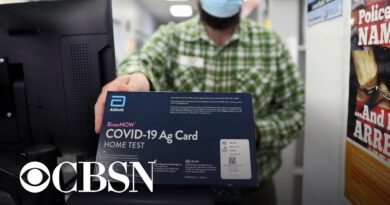What Required Minimum Distribution Is And How To Calculate It
The stock market had a good run in 2023: The NASDAQ alone rose more than 43%, while the S&P 500 gained 24% and the Dow ratcheted up nearly 14%.
Higher returns on investments are nothing to fret over, but it could lead to unexpected financial consequences for seniors. That’s because of required minimum distributions (RMD), which are mandatory withdrawals that must be made from retirement accounts starting at age 73.
In part thanks to market performance swelling retirement funds, distributions will be super-sized in 2024: The cumulative RMDs at Fidelity Investments, one of the largest financial services firms in the world, will hit a record $25 billion.
“Due to the market high on Dec. 31, 2023, as well as having more clients who are now eligible, we anticipate RMDs in 2024 to be the largest ever,” Rita Assaf, Fidelity’s vice president of retirement products, told CNBC Select.
Since RMDs are taxed like regular income, larger distributions could bump eligible seniors into a higher tax bracket.
Below, find out how required minimum distributions work, what the tax implications are and what you can do with the funds you withdraw.
What is a required minimum distribution?
A required minimum distribution is the amount you must withdraw from your retirement accounts annually starting at age 73. These withdrawals were established when IRAs were established in the early 1970s, essentially to ensure the government gets to collect income tax on tax-deferred accounts.
In 2023, the Secure Act 2.0 bumped the age that RMDs must begin from 72 to 73. (It will increase again, to 75, in 2033.)
Generally, RMDs must be withdrawn by Dec. 31 in the year you turn 73. Your first distribution, however, can be delayed until April 1 of the following year. So, if you turn 73 on Oct. 1, 2024, you have until April 1, 2025, to take your first RMD.
But, if you wait, you’ll have to take out two distributions in 2025.
RMDs must be taken from employer-sponsored retirement accounts — including 401(k), 403(b) and 457(b) plans — as well as from traditional IRAs and IRA-based plans, like SEPs, SARSEPs and SIMPLE IRAs.
Roth IRAs are exempt from RMDs while the owner is alive, although beneficiaries are subject to the RMD rules.
Starting in 2024, Roth 401(k) accounts are no longer subject to RMDs, either.
How are required minimum distributions calculated?
A required minimum distribution is determined by dividing the balance in an account at the end of the prior calendar year by your life expectancy as determined by the IRS.
If you are 75 and single, for example, the IRS says you can expect to live an additional 24.6 years. If the balance in your IRA at the end of 2023 was $150,000, you’d need to divide $150,000 by 24.6 years. Your required minimum distribution, therefore, is $6,098.
You need to calculate the RMD for each retirement account you have individually. You can, however, make the total withdrawal from one account or a combination of accounts.
Compare investing products
How could RMD affect your taxes?
The money in a 401(k) or IRA has been growing tax-free. Once it’s withdrawn, however, “it becomes taxable income and must be declared on your tax forms,” says David John, senior policy advisor at the AARP Public Policy Institute.
If you delay your first distribution until the calendar year following your 73rd birthday, you’ll have to take out two distributions to catch up. That could push you into a higher tax bracket.
Everyone’s financial circumstances are different, but there are strategies that could reduce the tax implications. One option is a qualified charitable distribution: If you’re at least 70½ years old, you can make a direct donation of up to $100,000 from a taxable IRA to one or more charities.
If you’re still working, you can also defer the RMD on your employer-sponsored 401(k) or 403(b) until you retire. You’d still have to make withdrawals from any IRAs or other non-workplace accounts, as well as from older 401(k) that haven’t rolled over.
Assaf suggests retirees hold off claiming Social Security for as long as possible and use their retirement accounts as their primary income, spreading out the tax liability and reducing future RMD amounts.
“It can also help you maximize your Social Security income,” said Assaf. “Every year you delay claiming up to age 70, you get an 8% increase in your benefit.”
Learn more: 5 ways to reduce your taxable income
Whatever your required distribution, always check what the tax withholding is.
“Come tax time you may owe a lot,” says Kevin Martin, manager of the Tax Institute at H&R Block. “By default, it’s usually 10% withholding. Depending on the size of your accounts, that may not be enough. So, it’s important to leave enough over to pay your taxes.”
What happens if you don’t withdraw the full RMD?
If you fail to make your full distribution, the IRS can subject you to a tax penalty of 25% of the amount you need to withdraw. If you correct your mistake within two years, the IRS may decrease the penalty to 10%.
You might be able to get the penalty waived if you establish the shortfall was due to “reasonable error,” but the best way to avoid it is to stay on top of your distributions. According to John, retirement account providers typically contact investors about upcoming minimum distributions.
“The bank will say, ‘Look, on such and such a date, if we don’t hear from you, we’re going to transfer this percentage of your balance into your checking account,'” John said.
You can also calculate your required minimum distributions using the IRS’ life expectancy chart.
What to do with the money you withdraw
There’s not much you can do to avoid RMDs. But you can be smart about the funds once you have them.
“If you need that money to live on, the best option is to put it in an account where you can get it very quickly,” said John. “And somewhere that it’s not going to be seriously affected by market ups and downs.”
High-yield savings accounts can generate generous returns while still providing easy access.
LendingClub offers a 5.00% APY, with no monthly fees and no minimum balance requirement after a $100 opening deposit. In addition, account holders are given a free ATM card and are allowed an unlimited number of withdrawals (up to a daily limit of $500).
LendingClub High-Yield Savings
LendingClub Bank, N.A., Member FDIC
-
Annual Percentage Yield (APY)
-
Minimum balance
No minimum balance requirement after $100.00 to open the account
-
Monthly fee
-
Maximum transactions
-
Excessive transactions fee
-
Overdraft fees
-
Offer checking account?
-
Offer ATM card?
Western Alliance Bank Savings Account
Western Alliance Bank is a Member FDIC.
-
Annual Percentage Yield (APY)
-
Minimum balance
-
Monthly fee
-
Maximum transactions
Up to 6 transactions each month
-
Excessive transactions fee
The bank may charge fees for non-sufficient funds
-
Overdraft fee
-
Offer checking account?
-
Offer ATM card?
If you don’t need the money in the short to medium term, the best way to handle it depends on your circumstances. You could invest it in the market or give it to family or a favorite charity.
“It’s a decision that every individual needs to make once they’ve gotten their hands on the money,” John said. “And if they have a financial advisor, it might be wise to talk to them.”
Compare savings accounts
Subscribe to the CNBC Select Newsletter!
Money matters — so make the most of it. Get expert tips, strategies, news and everything else you need to maximize your money, right to your inbox. Sign up here.
Bottom line
If you’re blowing out 73 candles this year, expect to start withdrawing a sizeable amount from your retirement fund. And if you’ve already been taking required minimum distributions, don’t be surprised if they’re larger this year.
Stay on top of your RMDs to avoid penalties and make a plan for the money you withdraw.
Meet our experts
At CNBC Select, we work with experts who have specialized knowledge and authority based on relevant training and/or experience. For this story, we interviewed David John, a strategic policy advisor at the AARP Public Policy Institute, where he works on retirement savings and pension issues. John also serves as a deputy director of the Brookings Institution’s Retirement Security Project.
We also spoke with Kevin Martin, manager of the Tax Institute at H&R Block, and Rita Assaf, vice president of retirement products at Fidelity Investments.
Why trust CNBC Select?
At CNBC Select, our mission is to provide our readers with high-quality service journalism and comprehensive consumer advice so they can make informed decisions with their money. Every tax guide is based on rigorous reporting by our team of expert writers and editors with extensive knowledge of personal finance products. While CNBC Select earns a commission from affiliate partners on many offers and links, we create all our content without input from our commercial team or any outside third parties, and we pride ourselves on our journalistic standards and ethics.
Catch up on CNBC Select’s in-depth coverage of credit cards, banking and money, and follow us on TikTok, Facebook, Instagram and Twitter to stay up to date.
Editorial Note: Opinions, analyses, reviews or recommendations expressed in this article are those of the Select editorial staff’s alone, and have not been reviewed, approved or otherwise endorsed by any third party.




